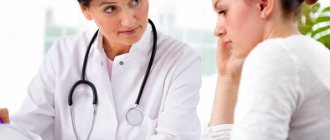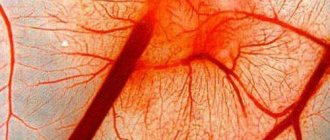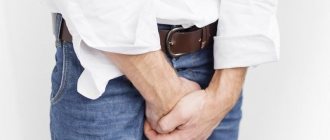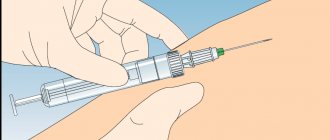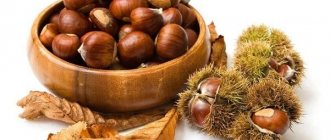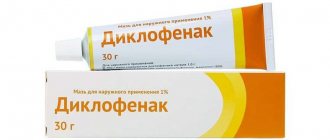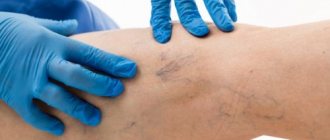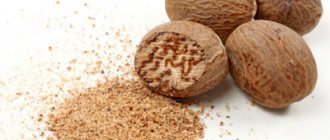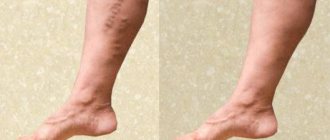The disease has very obvious external signs, so for the fair sex, varicose veins are, first of all, a cosmetic disease that affects appearance. However, do not underestimate the situation, because the problem lies not in how varicose veins manifest themselves, but in the problems inside the legs themselves.
The first signs of varicose veins of the legs
Small protruding veins are not scary yet, but they should make you think!
The initial stages of the disease are characterized by mild symptoms. However, a woman who is attentive to her health should not lose sight of these first signs of developing varicose veins:
- heaviness in the legs at the end of the day;
- swelling of the feet;
- the appearance of pigmentation on the skin of the lower legs and thinning of the skin;
- numbness of the limbs, frequent leg muscle cramps;
- protrusion of veins above the surface of the skin;
- the appearance of a pattern of veins and spider veins on the legs.
If, returning home after a day of work, a woman finds her feet in a “deplorable state,” then one should not blame only uncomfortable shoes or an extra “salt” at lunch. Swelling and heaviness in the legs are the first signal about the development of blood stagnation in the vessels. Remember, vein diseases are difficult to treat. Prevention in the early stages and timely medical care can stop or significantly slow down the process of vein stretching. Treatment must be started as early as possible.
Varicose veins 1st degree
The main causes of varicose veins are considered to be pregnancy, excess weight gain, prolonged physical activity, a sedentary lifestyle, as well as a genetic predisposition to such a disease. The common people called varicose veins “the disease of flight attendants” because of the peculiarities of this profession and the long standing on their feet. This degree of the disease is the mildest.
The disease is classified according to various factors. One of the classifications is based on the stages of development of the disease:
- Varicose veins of the 1st degree or stage of compensation.
- Varicose veins of the 2nd degree or stage of subcompensation.
- Varicose veins of the 3rd degree (photo below) or stage of decompensation.
Different stages of varicose veins of the lower extremities have radically different treatments. You should not try to cope with the disease on your own. This can only cause harm and lead to disastrous consequences. It is better to seek help from a competent specialist.
The first degree of varicose veins is characterized by swelling at night and nighttime cramps. Often people mistake all these symptoms for normal fatigue. However, already at this stage it is necessary to take preventive measures, which include warming up the feet to improve general blood flow, light foot massage, regular swimming, and cycling.
Also, varicose veins of the first stage can manifest themselves as cramps in the calf area; patients often complain of a feeling of spreading in the legs or burning in the muscles. This is increasingly often accompanied by pain in the lower extremities.
Already at this stage, visual manifestations may be noticeable, which should immediately alert you:
- Slight bluishness of the skin.
- Manifestation of the first spider veins.
- Visible tortuosity of veins.
Varicose veins of the first degree (see photo) are most often manifested by such external changes.
Another important factor in the manifestation of the first stage of varicose veins is the external conditions in which a person is located. For example, in a hot environment there is an increase in symptoms, swelling, pain and cramping.
Treatment of varicose veins of the first degree
Sometimes doctors recommend the additional use of venotonics, which are quite effective in the treatment of stage 1 varicose veins. It’s worth mentioning separately about massage: not every type of therapy is suitable for this ailment. If after the procedures the pain only intensifies, then it is necessary to change the approach to choosing a massage complex.
It is worth giving your feet relaxing cool baths more often, which will soothe muscles, relieve swelling, help reduce pain, and eliminate fatigue. But hot baths should be excluded, since they do not help improve the condition of the limbs with dilated veins.
Doctors may recommend the following treatment methods for varicose veins of this degree:
- Sclerotherapy is a special medicine injected directly into a vein using a needle. The action of the drug is aimed at resolving veins, strengthening weak vessel walls, and blocking blood flow in the desired area.
- Ozone therapy is aimed at strengthening blood vessels and resolving varicose veins.
Each of the above options is quite effective. However, the maximum effect can be achieved only if all the recommendations that must be followed after the procedures are used.
The primary thing is to wear special compression garments. This element helps create pressure in the veins, thereby preventing their further expansion.
Causes of the disease
There are more than fifty reasons that can provoke changes in the venous system. People whose profession involves stress on their legs and a sedentary lifestyle are especially susceptible to the disease: salespeople, hairdressers, programmers, accountants, drivers.
Scientists have conducted many years of research and identified the main factors that cause varicose veins:
- Hormonal changes in the body: pregnancy, menopause, adolescence;
- Obesity of any degree;
- Genetic predisposition. 70% of children whose parents suffered from venous insufficiency develop varicose veins;
- Weak muscular system;
- Wearing uncomfortable underwear: socks with a tight elastic band, tight underpants for men;
- Lack of activity and physical activity;
- The habit of crossing one leg over the other while sitting;
- Rare changes in body position: long standing, lying, sitting;
- Chronic diseases: diabetes mellitus, increased blood viscosity.
Out of ten people suffering from varicose veins, eight are female patients. The weaker sex is susceptible to venous pathologies due to forced hormonal disruptions during pregnancy, after childbirth, and during menopause. The second important factor why women suffer from leg pain more often than men is the love of high heels.
Rules and recommendations
At the initial stage of varicose veins, the patient is recommended to follow the following rules:
- Take walks once or twice a day. You should walk at a calm pace, stopping periodically to rest.
- Wear comfortable shoes with heels no higher than 3 cm. The upper part of the shoes should not have a compression device, and the laces should not be tied as tightly as possible.
- They attend training at the gym twice a week. Loads are selected individually by the doctor and trainer.
- Review your diet. Products high in sugar, fatty meats, flour products and starchy vegetables are excluded from food. Most of the diet of a patient with varicose veins consists of steamed or boiled vegetables. Fried and spicy foods are not recommended.
- In the evening, your legs need to rest. The outflow of blood will increase if you raise your legs and throw them on a high pillow or the back of the sofa.
- If the work involves a small amount of movement, it is recommended to lubricate the legs with refreshing gels or ointments that contain heparin.
- Special compression garments or an elastic bandage are used every day. Special underwear is selected by a doctor. The peculiarity of compression underwear is its compressive function. The pressure on the body occurs with different strengths, which forces the blood to circulate forcibly.
- Change positions frequently. If you have to sit constantly at work, then get up and sit down several times every 30 minutes. Exercise will help prevent varicose veins and hemorrhoids.
Latest information: Thrombosis after surgery
Traditional methods
Herbs and natural ingredients are effective for the prevention and treatment of varicose veins in the initial stages. It is important to use folk remedies regularly and for a long time.
Soothing foot bath
To prepare the bath you will need: three drops each of lavender and geranium oil, 2 tablespoons of sea salt, 200 ml chamomile decoction. The ingredients are poured into a warm foot bath. The feet are immersed in heated water for 25 minutes, then thoroughly wiped and lubricated with troxevasin.
The benefits of the procedure increase if the bath is performed before bedtime. Oils and sea salt help strengthen blood vessels, tone and give elasticity to the skin.
Compress with herbal decoction
To prepare the decoction you will need dry herbs: calendula, mint, lemon balm, sage, St. John's wort. Herbs in equal parts (2 tablespoons each) are placed in a thermos, the mixture is poured with 1 liter of boiling water. The infusion should stand for 3 hours.
The broth is filtered. A gauze pad is moistened and applied to the area where varicose veins are located. The compress must be kept until it dries. The sore spot is lubricated with baby cream.
Lilac flower tincture
Fresh lilac flowers are placed in a half-liter jar. Flowers should take ? the entire container volume. Everything is filled with vodka and placed in a dark place for 20 days. The finished tincture is filtered. Take 20 drops orally three times a day before meals.
The tincture cleanses blood vessels, helps strengthen the walls and normalizes blood circulation.
Fresh tomato compress
Tomatoes contain a valuable element - lycopene, which gives the fruit its bright red color. The substance helps strengthen the walls of blood vessels.
To prepare the compress you will need 1-2 tomatoes. The amount of vegetables depends on the size of the affected area on the legs and the size of the tomato. Tomatoes are minced through a meat grinder or crushed in a blender.
The finished pulp is laid out on a gauze napkin, which is tied to the legs. The compress should be kept for 1 hour. Then the feet are washed off with warm water and lubricated with moisturizer.
Vitamin mixture for a healthy heart and blood vessels
At the initial stage of varicose veins, it is important to support the functioning of blood vessels and the heart. To prepare the vitamin mixture, take the following ingredients: 2-3 figs, honey - 2 tablespoons, 1 lemon with skin, ginger root 1 teaspoon, 3 cloves.
The ingredients are passed through a meat grinder and mixed thoroughly. The vitamin mixture is consumed 1 teaspoon per day, in the morning after meals.
At the initial stage, varicose veins can be cured using traditional methods, but it will take time and patience.
Treatment of different stages
Therapy that is effective in the initial stages may have the opposite effect in advanced pathology. The choice of treatment methods should be adequate to the stages of varicose veins:
Compression jersey
It is used at all stages of varicose veins, but the degree of compression should differ significantly at different stages of disease progression. At the initial stage of varicose veins, compression is used for preventive purposes during standing and sedentary work.
Compression can stop the development of varicose veins, but before therapeutic use, consultation with a phlebologist is necessary, since compression is dangerous by exacerbating the problem of venous outflow. At the stages of compensation and subcompensation for swelling and noticeable varicose veins, underwear of the first and second compression classes is usually prescribed.
The third compression class is used in cases of severe venous insufficiency. If lymphedema occurs, use fourth-class underwear. When treated in a hospital, hospital jersey is worn.
Folk remedies
Traditional medicine helps treat varicose veins in the early stages. The following remedies are widely practiced:
- applying cabbage leaves,
- compresses made from potatoes, wormwood and garlic;
- chestnut liqueurs,
- decoctions of hops and nettles.
However, the ease of use, accessibility, and mild action of folk remedies are combined with their low effectiveness (compared to medications), so the enthusiasm for these methods is fraught with the progression of the disease. Herbal medicine and compresses should be used after medical consultation and serve only as an auxiliary means of the main treatment.
Hirudotherapy
Treatment with leeches is indicated in rare cases of advanced stages of varicose veins. Sometimes leeches are prescribed for thrombophlebitis.
Leeches can provoke allergies and trophic ulcers, aggravating varicose veins. Currently, the method is being replaced by non-traumatic medications that contain anticoagulant components.
Medicines
Medicines help relieve symptoms of the disease. Tablets, capsules based on grape extract, chestnut, which are dietary supplements, are effective at the initial stage of varicose veins:
- antistax,
- Venitan.
At the compensation stage, troxerutin is prescribed as an adjuvant. Most ointments and gels contain heparin, which prevents blood clotting (lyoton). Much of the effect of ointments and gels is due to massage during application.
But at the stage of decompensation, the application of such products can cause additional skin manifestations. Relief of symptoms with medications often has a temporary effect and does not cure the cause of the disease.
Operations
Laser coagulation and sclerotherapy are minimally invasive techniques for excluding veins from the bloodstream. They are used for small diameter dilated veins in the initial stages of varicose veins (when getting rid of spider veins, spider veins).
Endovasal laser coagulation of varicose veins
Phlebectomy
Surgical removal of veins is indicated at the third stage of the disease, accompanied by trophic ulcers and complications. In some cases, varicose veins in the legs do not develop in accordance with the model presented in the stage-by-stage classification. For example, the symptoms of the first stage may be completely absent: a picture of subcompensation immediately appears.
Or, as the disease progresses, some signs of varicose veins are not added to the symptoms of the previous stage, but disappear. Therefore, at the beginning of the 21st century, Russian phlebologists, in addition to the stage-by-stage approach, adopted the international classification (CEAP), which takes into account the facts of the individual characteristics of the course of varicose veins and the effects of treatment when diagnosing the severity of the disease.
Why are varicose veins dangerous?
This disease will not go away on its own. Without proper treatment, the situation will only get worse. Enlarged veins in the legs can cause the following complications:
- Eczema and dermatitis
- redness, small blisters and cracks appear in the lower leg area. - Trophic ulcers
- either single or multiple “islands” can appear. More often they are weeping (a clear or bloody liquid constantly appears on their surface). Although these ulcers are shallow, they are very painful. - Thrombophlebitis
- may be accompanied by an increase in body temperature, redness of the skin, and pain both when walking and at rest. - A vein rupture
is accompanied by heavy bleeding. If such a complication occurs, immediate medical attention is required.
Symptoms
Symptoms of pathology in the beginning of varicose veins do not make people think about vein disease:
- feeling of heaviness in the legs;
- fatigue after walking.
They tend to be associated with flat feet, unusual high heels, uncomfortable new shoes, and lumbar osteochondrosis.
And only the visual detection of bluish dilated veins under the skin raises suspicion of the development of varicose veins.
Vascular mesh as the first sign of varicose veins appears most often under the knees
Women consult a doctor when they notice unpleasant cosmetic defects in the form of reddish venous “spiders” on the legs, under the knees, and on the skin of the thighs.
The “influx” of young women wishing to receive treatment from a phlebologist specializing in vein diseases is usually associated with the upcoming summer beach season and concern for appearance rather than health. With the help of tablets, they want to restore the beauty of the skin of their feet.
Pregnant women are more attentive to their condition. In addition to cosmetic changes, they note difficulty walking and increased fatigue in the evening.
The initial stage of the disease is indicated by the disappearance of clinical symptoms after lying down.
You can see for yourself by conducting the following experiment: measure the volume of the lower leg at the level of the ankles or calf muscles in the morning and evening after work. If the difference is more than 1 cm, there are signs of initial varicose veins.
Subsequently there are:
- pain in the legs;
- swelling in the feet;
- feeling of fullness and heaviness in the legs;
- muscle cramps at night;
- dilated veins become like dense strands of “snake” with darkened areas of the skin.
These signs are undoubted manifestations of venous insufficiency and require treatment.
Symptoms of varicose veins
The first symptoms that appear in the initial stages:
- legs get tired quickly;
- short-term swelling appears;
- there is pain in the veins;
- At night there are cramps in the calves;
- There is a feeling of burning, fullness, heaviness in the legs.
A characteristic feature of pain in chronic venous diseases is its localization in the calf muscles. The pain is never sharp and does not radiate to the hip or foot. The sensations are moderate, pulling, dull, appear in the evening, disappear after a night's rest i Zhane A.K. Possibilities of diagnosis and treatment of chronic diseases of the veins of the lower extremities / A.K. Zhane [et al.] // Kuban Scientific Medical Bulletin. - 2010. - No. 9 (123). - pp. 78-84..
There are no dilated veins in the initial stages, but the disease is already developing. Sometimes this takes decades.
Gradually the symptoms intensify, signs of venous insufficiency appear:
- Swelling of the legs. In patients with chronic venous diseases, the volume of superficial tissues in the distal parts of the leg usually increases, while swelling, as well as pain and heaviness, occurs in the afternoon and regresses by the morning. Swelling of the foot, which is a symptom of disorders of lymphatic edema (lymphedema), is not typical for venous pathology. i Zhane A.K. Possibilities of diagnosis and treatment of chronic diseases of the veins of the lower extremities / A.K. Zhane [et al.] // Kuban Scientific Medical Bulletin. - 2010. - No. 9 (123). - pp. 78-84..
- Skin itching.
- Nodes visible to the naked eye, dilated veins, pathological tortuosity.
- Darkening, thickening of the skin, acquiring a brownish or bluish tint.
As the disease progresses, the symptoms intensify, signs of nutritional deficiency in the legs appear - deterioration in the condition and appearance of the skin, eczema, trophic ulcers.
You can find out the causes of varicose veins in consultation with our specialist.
Addresses of our clinics: St. Petersburg, Manezhny lane, 13 Chernyshevskaya metro station
St. Petersburg, st. Bolshaya Raznochinnaya, 27 metro station Chkalovskaya
The main causes of varicose veins in women
Fatigue and swelling may be the first manifestations of impaired venous blood flow
The sex hormone estrogen plays a special role in the development of varicose veins in women. Its action leads to such troubles as weight gain, depression, swelling, drowsiness, and dry mucous membranes. This hormone increases the permeability of small vessels. Fluid easily leaves the bloodstream, and the blood becomes less fluid. Excess fluid accumulates in the surrounding tissues. These factors contribute to the development of stagnation in the vessels of the lower extremities.
Update: Blood Thinning Products
Reasons for increased estrogen in women:
- Imbalance in the production of estrogen-progesterone. Occurs as a result of a decrease in progesterone levels in a woman’s body;
- Chronic stress. During stress, the body produces cortisol, which in turn inhibits the synthesis of progesterone;
- Pregnancy. During pregnancy, the amount of estrogen in a woman's body increases;
- Taking contraceptives. Varicose veins occur as a side effect of taking these medications;
- Liver diseases, since estrogen is removed from the body by the liver. When its function is poor, this hormone accumulates in the body;
- Age-related changes in hormonal levels also lead to an imbalance of sex hormones with a predominance of estrogen.
Separately, the reasons for the development of varicose veins should be noted overweight and genetic predisposition to this disease. If excess weight can and should be fought for the sake of health in general, then genetic predisposition cannot be prevented. As a result of these factors, varicose veins have become significantly “younger” and are now often found in girls 16-20 years old.
To maintain normal hormonal levels, proper liver function is important. In addition to removing excess hormones, it is involved in the synthesis of substances - precursors of progesterone and estrogen. To improve its functioning, physical activity, good nutrition, and minimizing the intake of toxic substances into the body are necessary.
Treatment of varicose veins using traditional medicine
Treatment of varicose veins on the legs with medications is the most effective method, which is suitable for almost all patients. A wide selection of medications allows you to choose a more suitable drug for long-term treatment.
Medicinal methods for treating varicose veins of the legs
The most highly effective drugs for the treatment of this disease include venotonics. Venotonics are drugs that help increase the tone of the veins and improve the outflow of blood from the veins.
The following venotonics are distinguished for varicose veins of the legs:
- Antistax - available in the form of capsules for oral use, gel and spray, helps improve blood circulation in small vessels, and also copes well with swelling and other unpleasant symptoms of varicose veins;
- Venitan – has an anti-inflammatory effect, which is recommended for use in cases of pain;
- Phlebodia 600 – increases the tone of the vein walls and actively reduces their lumen;
- Detralex - helps reduce the extensibility of the walls; with the permission of a doctor, it can be used by pregnant women.
This is only some of the venotonics that are recommended for use already in the initial stages of development of the described disease. The presented tablets can prevent the formation of characteristic varicose veins and the formation of nodes.
Application of ointments
The best treatment for varicose veins of the legs is an integrated approach, which includes medications in the form of tablets, as well as the use of gels and ointments for external treatment of problem areas.
Ointment for varicose veins on the legs also helps improve blood flow and prevent the formation of blood clots. Among the most popular and effective are:
- Lyoton-gel - the gel is applied to the legs several times a day, this use of the product helps to thin the blood, which improves outflow;
- Thrombophobe – helps reduce swelling;
- Venolife - using this product helps restore the damaged structure of the venous system.
The above products are recommended for use only after consulting a doctor, who will also determine the duration of treatment and the regimen of use.
You should not self-medicate - this can further harm the patient’s already poor condition.
Drug therapy of traditional medicine
This therapy is prescribed for stages 2-3 of varicose veins. It consists of taking medications that have the following properties:
- relieve pain;
- thin the blood;
- increase the elasticity of blood vessels;
- normalize local metabolism;
- stop inflammatory processes.
The following drugs are used for these purposes:
- diclofenac – relieves inflammation;
- aspirin – reduces blood viscosity;
- preductal – promotes wound healing;
- detralex, phlebodia - prevent swelling, strengthen the elasticity of blood vessels, have a lymphatic drainage effect;
- chimes - improves blood circulation in the legs, prevents the formation of blood clots.
Along with oral medications, agents for external use are prescribed - gels, creams, ointments. They contain substances that moisturize, relieve inflammation and improve vein tone:
- aescin;
- Lyoton-gel;
- heparin ointment;
- troxerutin, etc.
Consequences of varicose veins.
Varicose veins (see photo) can lead to the development of trophic ulcers on the leg, to thrombosis in the varicose vein system, to thrombophlebitis, to pulmonary embolism (instant death) in the midst of apparent complete health.
Complicated stages of varicose veins require surgical intervention. Although varicose veins most often affect women, men are also affected by this disease, mainly for hereditary reasons.
A man under the age of 40 can be on the operating table, and to cure him of varicose veins, radical measures are used - diseased veins are removed.
Removing varicose veins is easy.
The surgeon makes an incision in the groin area, where the large saphenous vein, affected by varicose veins, flows into the femoral vein. The vein is isolated, ligated and excised, and a second incision is made at the level of the ankle. Using a special metal probe, which is inserted into the lumen of the vessel, the dilated vein is completely removed.
In the future, with the correct surgical technology, no relapses are observed. The blood supply in the leg is distributed to other vessels, and after 2 weeks everything is completely restored.
Risk factors predisposing to the development of varicose veins.
— Genetics and pathology of connective tissue; - Female; — Taking hormonal drugs: progesterone, estrogen; — Pregnancy; — Age: after 50 years it occurs more often; — Excess weight and physical inactivity; — Prolonged stay in a vertical position (standing work: hairdressers, salespeople, teachers, etc.); - Obesity.
Symptoms and signs of varicose veins and chronic venous insufficiency.
| Symptoms of varicose veins | External signs |
| Aching pain | Telangiectasia |
| Heavy legs | Reticulum veins |
| Fast fatiguability | Varicose veins |
| Swelling | Thrombophlebitis |
| Itchy skin | Hyperpigmentation |
| Discomfort in the legs | Bleeding nodes due to injury |
| Cramps in the calf muscles | Ulcer formation |
Treatment options for varicose veins.
The choice of treatment depends on the diameter and type of varicose veins
— Varicose veins of the saphenous veins — Drug therapy — Elastic compression and leg bandaging — Injection sclerotherapy — Foam sclerotherapy — Laser therapy — Miniflebectomy
Dear women, varicose veins can forever trap you in long skirts and trousers. If pills and ointments are not able to normalize your legs, then the only sure way to remove dilated veins remains. In what way and where, this is only after consultation with a phlebologist. Veins can now be surgically treated without hospitalization, without anesthesia, without incisions, and with high precision. You just need to take a step towards your health.
Detailed information about varicose veins, symptoms, disease prevention, special exercises, treatment methods and necessary nutrition can be found on the website: ovaricoze.ru
Latest information: HeadingsLatest posts
general characteristics
Varicose veins on the legs can affect men and women of any age, but are more common in middle-aged and elderly patients. Varicose veins are a very common disease. Up to 15% of older men and virtually all older women suffer from this disease.
Risk factors for developing pathology:
- presence of illness in close relatives;
- sedentary lifestyle;
- overweight;
- long periods of standing;
- pregnancy.
What to do at the first signs of varicose veins on the legs
2 comments
Congestion in the vessels of the lower extremities is a common phenomenon, especially in adulthood. The “scourge” of the modern urban population is physical inactivity – a consequence of a sedentary, sedentary lifestyle. As a result of a lack of movement, the musculoskeletal system and the cardiovascular system are primarily affected. Without proper physical activity, the load on the veins of the legs increases significantly, due to disruption of the natural outflow of blood, which should be helped by muscle activity.
When muscles contract, the volume of blood is actively pushed out through the veins of the legs. Without contraction of the surrounding muscle tissue, the movement of blood through the veins is carried out by the heart and its own venous valves. Prolonged standing, sitting, wearing tight shoes and clothes, excess weight and hormonal imbalances - all these factors lead to varicose veins.
According to statistics, 25-30% of women and only 10-20% of men have varicose veins at one stage or another. The reasons for such a prevalence of venous disease in women are associated with hormonal characteristics, bearing and giving birth to children, and with the characteristics of fashionable women's shoes.
How varicose veins manifest themselves in the early stages Why they are dangerous
As a rule, reticular varicose veins are painless. Therefore, the most common complaints that patients turn to doctors with are cosmetic defects - visible reticular veins.
In more rare cases, the appearance of such varicose veins is accompanied by a burning sensation or other changes in skin sensitivity.
In addition to these symptoms, the first stage of varicose veins manifests itself:
- heaviness in the legs;
- increased fatigue of the legs;
- muscle cramps of the lower extremities, especially at night;
- itching at the site where the spider veins appear;
- swelling of the feet and legs.
To prevent the progression of the disease, it is necessary to begin its treatment on time.
Therefore, it is important to promptly consult a phlebologist, angiologist or vascular surgeon, who will tell you what to do with such skin formations. To begin with, the specialist will conduct an examination and prescribe the necessary additional examinations that will help identify the causes of the appearance of stars or meshes, as well as determine the degree of venous circulation impairment
We recommend!
To determine the degree of vascular damage and their insufficiency, do the following:
- complete blood count (shows whether the patient has anemia or thrombocytopenia);
- biochemical blood test (detects disorders of blood clotting or liver and kidney function);
- general urine test (detects kidney problems);
- Ultrasound examination of blood vessels - duplex angioscanning (detects pathology of the vascular wall and blood flow disorders);
- X-ray venography with contrast (determines the location of damage to the veins and the degree of impairment of their functions).
If you do nothing after detecting the first signs of reticular varicose veins, it is possible:
- the addition of inflammation and the development of thrombophlebitis of the superficial veins of the lower extremities;
- transition of the pathological process from the superficial veins of the lower extremities to the deep ones;
- thrombosis of venous vessels. If such thrombosis occurs in the venous vessels of the head, it is dangerous due to strokes and sinus thrombosis;
- Pulmonary embolism is a deadly complication that occurs due to the detachment of a blood clot from the vessel wall and blockage of the lumen of the pulmonary arteries.
If you ignore the appearance of incipient reticular varicose veins and do not start treatment in a timely manner, the disease will progress. Then the development of complications will become inevitable.
Diagnostics
The examination is carried out by phlebologists. Only then, if necessary, do they involve other specialists. Among the techniques:
- Oral survey. The doctor must understand what complaints the patient himself is making.
- Anamnesis collection. Investigate the likely origin of the problem.
- Visual assessment of the condition of the legs. Based on the signs, it is possible to study the nature of the pathological process and its features.
- Palpation. Physical technique.
- Ultrasound Doppler. Dopplerography of leg vessels. Allows you to detect anatomical changes in the lower extremities and deviations in blood flow velocity. Used as the main technique. Makes it possible to quickly make a diagnosis and study the degree of the disorder.
- X-ray. If there is such a need.
- In particularly difficult cases, the doctor prescribes an MRI.
The development of varicose veins on the legs is a sufficient, visually characteristic sign of dilation of the veins of the lower extremities; it can be used to make a diagnosis. Next, it remains to determine the severity of the pathology.
